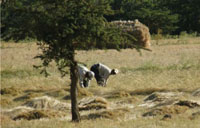6.2.5 Population movement and migration
Population movements have significant implications for malaria transmission. The majority of the population movements in Ethiopia involve people moving from the highlands to the malaria-endemic lowlands as seasonal labourers. These people are often employed as daily labourers in the crop fields during the planting and harvesting seasons (Figure 6.6), when malaria transmission is at its peak. The poor living conditions and inadequate health care in such agricultural projects often worsen the problem of malaria. Migrants from malaria-free highlands lack immunity against the disease, as well as the appropriate knowledge of the transmission process and how to avoid being bitten by mosquitoes.

Migration for the purpose of permanent settlement in a new area is also common in Ethiopia and is a major factor associated with malaria transmission. Migration is often from densely populated highlands to malaria-endemic lowlands, where the population density is low and the soil is more fertile. Major environmental transformations like deforestation, and new construction etc, take place during resettlement, enhancing the proliferation of mosquito breeding sites, and resulting in major malaria outbreaks.
Population movements and migration also make the malaria problem worse in the areas from which the migrants came. Temporary migrant workers often bring the parasites back to the malaria-free highlands and local transmission can be readily established as many of these communities could support vector breeding. Such sporadic epidemics could affect a large number of people, as the population in malaria-free areas is generally non-immune.
You will learn about drug-resistance when we describe malaria case management in Study Session 8.
Large population displacements can also occur rapidly due to causes like war and civil unrest, or natural causes like drought and famine, flooding and earthquakes, etc. Displaced people from areas with malaria can introduce or reintroduce malaria into areas that are malaria free, and in some cases spread drug-resistant malaria. Displaced populations can in some cases be at a higher risk of getting sick or dying from malaria because:
- Displaced people may not have proper housing.
- They often camp near water bodies that serve as mosquito breeding sites.
- They could be non-immune, if moving from malaria-free to malaria-endemic areas.
- Malnutrition can worsen the malaria problem.
- The health care system can be overburdened, so there may be very limited malaria care and preventive measures.
Though the chance of large scale population displacement due to social and natural disasters is rare in Ethiopia, it is important for you to keep in mind that displacement can worsen the problem of malaria.
6.2.4 Urbanisation
